The very first touch of a volunteer was picking up rubbish along the beach at Pasir Ris Park. On and off, volunteer works were part of the school curriculum. Truthfully, I would think those were transactions instead---in exchange for the points on my report cards to move on to the next level.
My teacher once said, “Many people do volunteer activities not for the needy; they do that for themselves. How do you feel when you’re volunteering? Feel good.
We are all selfish. People volunteers because they want to feel nice, feeding the desire of inner-emptiness. You walk down the street, give some money to a street beggar--- and you feel good. Are you really helping the beggar? You are using them to make you feel superior. “
I couldn’t quite catch this idea at first. It probably sounded a little too harsh for me. From time to time, I started to be more awareness of my emotions and thoughts. Quite right though.
Commonly in Singapore we would hear “Please call 1800-112-XXXX to donate” after screening the life stories of the needy. Tearing in front of the screen; grabbed the phone and pressed the buttons. And right after, a surge of good feeling slipped in! Ah… done a good deed today. One may not witness this coming, while still enjoying the gush of emotions. Why?
When the act of helping is part of our everyday activities, whether it is for your neighbors, family, friends or strangers--- it’s a norm to us. If this act is not something that we used to do; and do it only for certain reason--- it’s an occasion, especially different.
Of course, there’s absolutely nothing bad about being a volunteer for which ever reasons. We all have to start somewhere--- selfishness to self-less ness.
Having myself to be involved with small-scale projects has given me opportunities to know myself better. It doesn’t matter whether the needy are from Singapore or India--- there’s no ground of comparison.
Instead of looking for the differences that create bricks between you and me; why not discover our similarities which encourage unity among humanity?






















